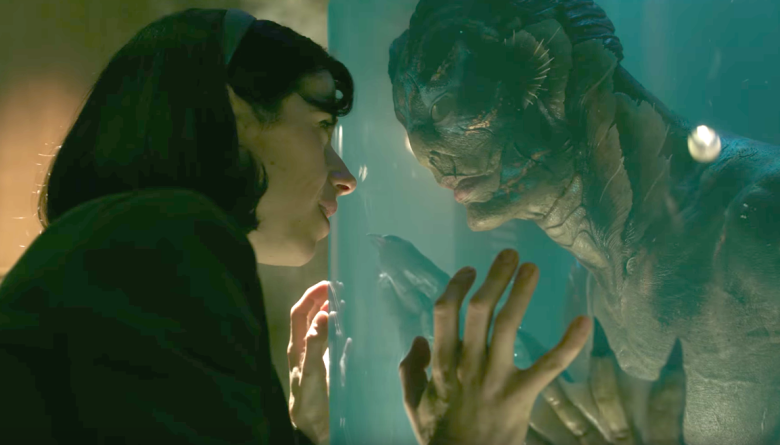A classic love story with a reptilian twist, Guillermo del Toro’s latest love letter to cinema, The Shape of Water, is a marvel to behold. Set against the backdrop of 1960’s America and the accompanying Cold War paranoia, each frame of the film feels meticulously crafted. Marked by dark shadows and moody lighting, the film has a distinct noir feel. Yet punctuating the aesthetic gloom is a story brimming with light and indefatigable charm. It’s del Toro’s most sophisticated work to date, a master-class in mood setting and emotionally affecting filmmaking, even if it feels a little too self-satisfied at times.
The story follows Eliza (Sally Hawkins), a mute janitor who feels “incomplete”. She lives in a quaint apartment atop of a movie theatre and spends her days as a cleaner in a top-secret government facility. There she falls in love with an amphibious fish-like being (Doug Jones) who is imprisoned by the government and subject to cruel studies and experiments. Taken aback by the way the creature sees her for what she is, not what she isn’t, she falls in love and conspires with her co-worker (Octavia Spencer) and neighbour (Richard Jenkins) to break the creature out.
Once the love story takes shape, it doesn’t deviate from the expected. Del Toro seems less interested in developing a complex narrative but rather providing depth through the film’s mise-en-scene. While, at times, this makes the story feel a little stagnant and complacent, del Toro is nothing if not a distinct visual stylist. Set in 1962 Baltimore, the quintessential Americana setting is juxtaposed with French styled influences. The film’s whimsical elements feel like del Toro channelling the work of Jean-Pierre Jeunet, with the music, quirky characters, quaint sets and surreal slant all trademarks of Jeunet’s work. The film is a celebration of cinema just as much as it is about the power of imagination. It’s a joy to behold and a latter half homage to Fred Astaire, by way of standout musical number, is one of the many inspired choices throughout the film.
What allows the narrative to flourish, however, is Sally Hawkins’ emotionally charged performance. She is able to communicate a wealth of emotion without uttering a single word. Her delicate and understated performance anchors the fanciful story and provides nuance to the central romance between Eliza and the creature. The companionship they share is one of deep humanity and, in world too quick to judge, Hawkins’ layered performance ensures their relationship never feels unbelievable.
The Shape of Water is ultimately a story about the importance of communication and understanding at a time when otherness was seen as threatening and unwelcome. The parallels to the present day are not hard to draw and while the story plays it a little safe, del Toro paints it with a tenderness few artists achieve. The purity of vision on display is the work of master auteur and something seen far to rare these days. The Shape of Water is a classic love story, told with modern relevance and truly a tale for our troubled times.
(4.5/5)
Dominic Kwaczynski

